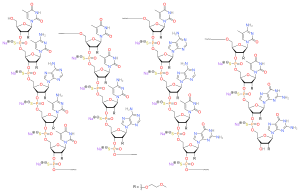 | |
| Clinical data | |
|---|---|
| Trade names | Spinraza |
| Other names | IONIS-SMNRx, ISIS-SMNRx |
| AHFS/Drugs.com | Monograph |
| MedlinePlus | a617010 |
| License data |
|
| Pregnancy category |
|
| Routes of administration | Intrathecal |
| ATC code | |
| Legal status | |
| Legal status | |
| Pharmacokinetic data | |
| Bioavailability | 100% (intrathecal) |
| Protein binding | <25% (in CSF), >94% (in plasma)[6] |
| Metabolism | Exonuclease (3'- and 5')-mediated hydrolysis |
| Elimination half-life | 135–177 days (in CSF), 63–87 days (in plasma) |
| Identifiers | |
| |
| CAS Number | |
| PubChem CID | |
| DrugBank | |
| ChemSpider | |
| UNII | |
| KEGG | |
| Chemical and physical data | |
| Formula | C234H323N61Na17O128P17S17[4] |
| Molar mass | 7500.86 g·mol−1 |
| |
Nusinersen,[7] marketed as Spinraza,[4] is a medication used in treating spinal muscular atrophy (SMA), a rare neuromuscular disorder.[8][4] In December 2016, it became the first approved drug used in treating this disorder.
Since the condition it treats is so rare, Nusinersen has so-called "orphan drug" designation in the United States and the European Union.[9]
- ^ "Prescription medicines: registration of new chemical entities in Australia, 2017". Therapeutic Goods Administration (TGA). 21 June 2022. Retrieved 9 April 2023.
- ^ "Prescription medicines and biologicals: TGA annual summary 2017". Therapeutic Goods Administration (TGA). 21 June 2022. Retrieved 31 March 2024.
- ^ "Genetic disorders". Health Canada. 9 May 2018. Retrieved 13 April 2024.
- ^ a b c d Cite error: The named reference
Spinraza FDA labelwas invoked but never defined (see the help page). - ^ "Spinraza EPAR". European Medicines Agency. 2 April 2012. Retrieved 29 June 2024.
- ^ Paton D (2017). "Nusinersen: antisense oligonucleotide to increase SMN protein production in spinal muscular atrophy". Drugs of Today. 53 (6). Clarivate Analytics (US): 327–337. doi:10.1358/dot.2017.53.6.2652413. ISSN 1699-3993. PMID 28799578.
- ^ a b "International Nonproprietary Names for Pharmaceutical Substances (INN). Recommended International Nonproprietary Names: List 74" (PDF). World Health Organization. pp. 413–414. Retrieved 13 March 2017.
- ^ Ottesen EW (January 2017). "ISS-N1 makes the First FDA-approved Drug for Spinal Muscular Atrophy". Translational Neuroscience. 8 (1): 1–6. doi:10.1515/tnsci-2017-0001. PMC 5382937. PMID 28400976.
- ^ "Nusinersen". UK Specialist Pharmacy Service. 28 January 2016. Archived from the original on 13 April 2019. Retrieved 31 December 2016.